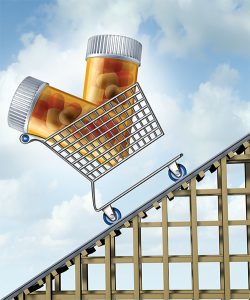
Lightspring/shutterstock.com
LONDON—The availability of a biosimilar form of infliximab has dramatically increased the number of Norwegians taking one form or another of the drug, an expert on biosimilars said in a debate-style session at the Annual Congress of the European League Against Rheumatism (EULAR 2016).
The expanded uptake of Remicade (infliximab) and its biosimilar, Remsima (international non-proprietary name: infliximab), in Norway and elsewhere in Scandinavia is a striking illustration of the impact that newfound affordability of a drug can have in meeting the needs of patients, said Tore Kvien, MD, head of rheumatology at the University of Oslo and Diakonhjemmet Hospital.
On the flip side, Ronald van Vollenhoven, MD, PhD, director of the Amsterdam Rheumatology and Immunology Center, said there could be a downside to biosimilars if less money is spent on research and development and if regulatory oversight can’t keep up with the increase in manufacturing.
Dr. Kvien argued that biosimilars “could potentially improve accessibility to good therapies for more people with rheumatic and musculoskeletal diseases. For me, that really is the main idea.”
Overcoming the Cost Barrier
Access to disease-modifying drugs is a problem, especially in countries with lower incomes, according to a study of countries in Europe published in 2014.1
Biosimilars are a potential solution. Nationally collected data show that Remsima was the cheapest tumor necrosis factor inhibitor in that country in 2014, costing 39% less than Remicade. In 2015, the difference was even greater, with Remsima costing 69% less.
Norway has a national “tender system” in which drug companies offer a price for their products and a committee determines the annual cost for various indications. This calculation is a key driving factor in which drugs are prescribed and used by patients.
“If you compare for rheumatoid arthritis, we could treat five patients with Remsima for the same cost as one patient with [Remicade],” Dr. Kvien said.
Acceptance in Scandinavia
Beginning in 2014, when Remsima became available, prescriptions for the biosimilar began to outpace those for Remicade. And the outpacing was even greater in 2015. Remsima now has between 80 and 90% of the market share, Dr. Kvien said.
Prescribing of Remsima has not been as dramatic everywhere in Scandinavia. In Sweden, which has different pharmaceutical financial mechanisms, the uptake has been much lower. But in Denmark—where use of the biosimilar became mandatory in 2015—uptake has been even greater than in Norway, Dr. Kvien said.
Also in Denmark, total infliximab prescriptions leaped from 7,000 in 2014 to a total of about 14,000—the originator and the biosimilar combined—by the end of 2015. In Norway, the total number of prescriptions jumped from about 7,000 to about 13,000 over that period.
There could be a downside to biosimilars if less money is spent on research & development & if regulatory oversight can’t keep up with the increase in manufacturing.
In the Pipeline
More biosimilars are on the way: Data have been presented or published on nearly 20 biosimilars for rheumatic diseases, a 2016 study found.2

